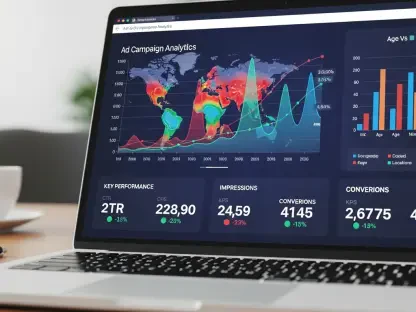Imagine a world where marketing budgets are no longer a guessing game, but a precise science driven by data and artificial intelligence, capable of predicting outcomes with uncanny accuracy. In today’s digital landscape, brands face the daunting challenge of navigating fragmented channels, privacy constraints, and outdated attribution models that fail to capture the full impact of their campaigns. Enter Monks’ iBQML, an innovative Marketing Mix Modeling (MMM) tool built on Google’s BigQuery ML (BQML), designed to transform how marketers measure ROI and optimize strategies. This review dives deep into the capabilities of this cutting-edge technology, exploring its role in addressing modern marketing dilemmas and reshaping audience targeting in a privacy-conscious era.
Understanding the Core of iBQML in Digital Marketing
At its heart, iBQML represents a paradigm shift from traditional attribution methods like last-click models, which often misrepresent the value of channels by focusing solely on final conversions. Developed by Monks, this AI-driven solution offers a comprehensive view of marketing performance across multiple touchpoints, providing brands with actionable insights into how each channel contributes to overall success. Its emergence comes at a critical time when data fragmentation and evolving consumer behaviors demand more sophisticated tools to bridge the gap between tactical execution and strategic goals.
The significance of iBQML lies in its ability to tackle pressing industry challenges, such as the undervaluation of platforms like TikTok in full-funnel campaigns. By leveraging advanced modeling, it captures the nuanced interplay of brand awareness, engagement, and conversion, ensuring budgets are allocated with precision. Furthermore, its focus on aggregated data aligns with tightening privacy regulations, making it a forward-thinking solution for marketers aiming to stay compliant while maximizing impact.
Technical Features and Capabilities of iBQML
Seamless Integration with BigQuery ML for Scalability
One of the standout strengths of iBQML is its foundation on Google BigQuery ML, a platform that empowers scalable analytics by breaking down data silos. This integration allows for rapid predictive modeling, enabling brands to process vast datasets and generate insights without the bottlenecks of traditional systems. The tool’s use of SQL-based model creation further democratizes access, allowing teams to build and validate models with statistical rigor.
Beyond scalability, iBQML excels in forecasting campaign outcomes with a high degree of accuracy. Its ability to simulate various budget scenarios helps marketers anticipate the impact of their decisions before committing resources. This technical prowess ensures that even complex, multi-channel campaigns can be analyzed efficiently, providing a competitive edge in fast-paced digital environments.
Real-Time Optimization and Audience Engagement
Another key feature is iBQML’s capacity for real-time optimization through hourly pipeline updates, ensuring that media spend adjustments reflect the latest performance trends. This dynamic approach minimizes wasted budget and maximizes efficiency, particularly in volatile markets where consumer behavior shifts rapidly. The tool’s integration with Google Analytics and Google Marketing Platform also streamlines audience activation, automating targeting processes for enhanced precision.
Additionally, features like normalized segment sizing allow for consistent analysis across diverse audience groups, ensuring that insights are both granular and comparable. This capability enables marketers to tailor campaigns to specific demographics without losing sight of broader strategic objectives. The result is a system that not only reacts to data but proactively shapes outcomes through intelligent automation.
Industry Trends Influencing iBQML’s Evolution
The development of iBQML is closely tied to several transformative trends in marketing analytics, starting with the industry-wide pivot toward privacy-safe methodologies. As regulations tighten globally, the reliance on aggregated data rather than user-level tracking positions MMM tools like iBQML as compliant alternatives that still deliver robust insights. This shift is crucial for brands seeking to balance performance with ethical data practices.
Artificial intelligence continues to play a pivotal role, drastically reducing the time needed to develop complex models from months to mere weeks. This acceleration allows marketers to stay agile, adapting strategies on the fly to meet emerging demands. Moreover, the growing adoption of MMM—already embraced by over half of U.S. marketers—signals a broader consensus on the need for holistic measurement frameworks, with iBQML at the forefront of this movement.
Real-World Impact Through Case Studies
The practical value of iBQML shines through in its application across diverse industries, demonstrating measurable results for brands willing to embrace data-driven strategies. For instance, a consumer electronics company saw a 23% higher ROI on TikTok after iBQML identified an optimal investment range, leading to a 171% increase in ad spend on the platform. This case highlights the tool’s ability to uncover hidden potential in often-underestimated channels.
In another example, Suntory Wellness used time-varying MMM to prioritize Google Performance Max and YouTube campaigns, achieving sustained impact through focused allocation. Similarly, Nexon harnessed causal inference to optimize cross-channel synergies, while TaxSlayer reduced its cost-per-acquisition by 32% through streamlined data consolidation. These successes collectively illustrate how iBQML aligns marketing efforts with tangible financial outcomes, proving its worth as a strategic asset.
Challenges and Areas for Improvement
Despite its strengths, iBQML is not without limitations, particularly in delivering granular, real-time incrementality data compared to alternative methodologies. While it excels in providing a high-level view of campaign performance, marketers seeking immediate, detailed insights may find it less suited for certain tactical needs. This gap underscores the importance of pairing iBQML with complementary tools for a more complete picture.
Market adoption also presents hurdles, as some organizations may lack the technical infrastructure or expertise to fully leverage its capabilities. Privacy and regulatory considerations, while addressed through aggregated data, remain an ongoing concern requiring constant vigilance. Monks is actively exploring hybrid approaches, combining MMM with multi-touch attribution and attention metrics, to mitigate these challenges and enhance the tool’s versatility.
Future Prospects in Marketing Analytics
Looking ahead, iBQML stands poised to evolve alongside advancements in AI and privacy compliance, potentially integrating even more sophisticated algorithms to refine its predictive power. Enhanced features could further address granularity issues, offering deeper insights into real-time performance without compromising data ethics. Such developments would solidify its position as a cornerstone of modern marketing analytics.
Broader industry adoption seems likely as more brands recognize the value of full-funnel visibility in navigating complex digital ecosystems. The tool’s ability to adapt to changing consumer expectations and regulatory landscapes will be key to its long-term relevance. As these trends unfold, iBQML could redefine how marketing strategies are crafted and executed over the coming years.
Final Thoughts on a Transformative Tool
Reflecting on this evaluation, it became clear that Monks’ iBQML has carved a significant niche in marketing analytics by offering unparalleled precision and scalability through AI and BigQuery ML integration. Its real-world impact across industries demonstrates a knack for turning data into actionable results, while its alignment with privacy norms addresses a critical industry need. The journey revealed both its technical strengths and the challenges that demand attention.
For marketers and brands moving forward, the next step involves integrating iBQML with complementary methodologies to cover its blind spots, particularly in real-time incrementality. Exploring partnerships or internal training to boost technical adoption could unlock its full potential. Ultimately, staying attuned to AI advancements and regulatory shifts will ensure that this tool remains a vital ally in crafting data-driven, future-ready marketing strategies.









